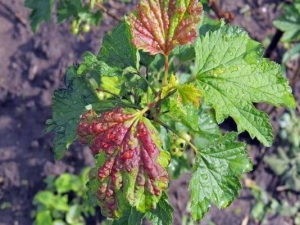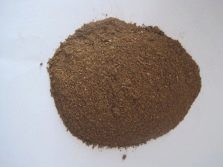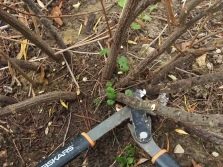Red spots on currant leaves: why appear and how to treat?

For many people who have a plot of land, currants are royal shrubs. And it is not surprising, because its berries are not only very tasty and fragrant, but also bring great benefits to the human body. To obtain a good harvest when growing this plant, it is necessary to give it proper attention and care.
In the summer season, gardeners may notice that red spots have appeared on the currant leaves. If a person is experienced, he will be able to quickly determine the cause and eliminate it. But a novice gardener will need to understand what caused this situation to take immediate action and save the plant.
Causes
For everyone involved in the cultivation of vegetables, fruits or berries, it is important to get a healthy and rich harvest. But in achieving this goal can prevent any disease or uninvited parasite, from which the plants dry. Often, in the warm season, the foliage of currants may have red bumps, brown and bulging spots, growths. Defeat can be not only on the red, but also on the black currant. The reasons for the appearance of these defects can be as diverse as their elimination.
Diseases
Currant bush often suffers from infectious and fungal diseases. We list the most common ones.
Septoria
Often this disease attacks the black currant bushes, the cause of all this is a fungus. In June, on the leaves you can see the appearance of brown spots of small size, which have a red border. In springtime, this disease affects the shoots and fruits of the plant, which is also covered by brown swellings. During this disease, the foliage may fall off and shrivel, the buds are not able to bloom. Accordingly, there is a significant decrease in yield. Infection persists in infected shoots and plant debris.
Brown spot
It also refers to diseases of the fungal nature. In the hot season, the currant bush is stained with brown color and irregular shape. These formations have a bright middle, over time, their size increases, and the boundaries merge. The edge of the spot is a brown rim. The affected tissues on both sides are covered with a gentle brownish patina - these are the sites of fungal sporulation. If severe contamination occurs, the foliage dries and falls prematurely.
Brown spot is a disease that reduces the yield of shrubs several times. This infection can persist in infected plant residues.
Anthracnose
You can notice the manifestation of this disease when the flowering phase of a currant ends. The peak of the development of a fungal infection is July and August. Often strongly affected leaves, as well as anthracnosis can be found on the petioles, young shoots and berries of the shrub. The onset of the disease is the formation of small bright spots that are isolated from each other. At each such defect there are glossy tubercles with spores. Over time, the spots become brown, and by merging together they form one large affected area.
Throughout the summer period, several generations of this fungus attack the currant. The stalks and young shoots are covered with gray-brown sores. No new shoots are formed on diseased bushes, foliage falls prematurely, weak yields are observed. The infection is able to persist in the bark of the shoot, which is affected by the fungus, as well as the rest of the plant.
Terry
The causative agent of the disease is phytoplasm. It can affect black, red and white currants. For the first time the disease progresses in the spring, its mass manifestation is observed approximately twelve months from the moment of infection. A long period of infection is in the latent phase, but at the same time has the ability to infect other plants. Infected currants can be recognized by the presence of double flowers.A sick bush lags behind healthy ones in the rate of bud break and also in flowering.
When the currant is twisted, the leaf, flower, and shoot are deformed. The five-leaf sheet becomes three-leaf, it is small and asymmetrical. Struck shrub has a large number of shoots, they are short and thin. Currants completely lose the flavor that is inherent in it. Terry turns pistils and stamens into scales with narrow parameters and purple color. Terry flower is unable to give the ovary, and, accordingly, the fruit.
Infection can be transmitted with planting material and cuttings.
Glass rust
The first symptom of the disease is the appearance of spots on the leaves with a small size and dark red color. When the disease spreads, the spots increase in size and merge together. As a result, the sheet curls and falls. If the plant is heavily infected, the infection attacks the shoots, where cracks become visible. Shoots break, and currants die. This type of fungus can spread to the berries. The disease begins to occur in June, and reaches its peak in mid-summer.
Pests
If the foliage color has changed on the currant bush, bloated brown blisters appeared, then the reason may be in the attack of gallic aphids. This is one of the most famous parasites attacking this plant. The most favorable period for its distribution is considered to be hot and dry summer, especially after warm winters. Wintering eggs of this insect occurs on the branches of the bush.
After budding, a larva appears from the egg and creeps to the lower side of the young leaf. The vital activity of the larvae is based on sucking the juices from the plant, during which the leaves become covered with brown bubbles, their redness is visible even with the naked eye and at a far distance. The reverse side of the blistering is hollows. Over time, the leaves curl and die.
In the summer, after stopping the growth process, the foliage grows coarse. At this time, the female gallic aphid begins to fly to other plants, where it continues its process of life activity. Not only currant bushes are eaten at this time, but also nettle, peppermint, lemon balm, sage. At the end of the summer period, the harmful insect returns to the currant for laying eggs, so that next year it can repeat its life cycle.
But also the whitefly strawberry can be the cause of the foliage deformation on the currant. It does not have the appearance of points like aphid, but resembles a small white butterfly, which is up to one and a half centimeters in length. The insect feeds on the back of the leaf, by sucking the juice out of it. In the same place, females lay eggs, from which larvae with six legs appear. The period of pest development takes about a month.
During the growing season, currants can be attacked about four times by new generations of whitefly. The entire life process of the pest harms many crops in the garden. When the period of cold comes, the parasite can hide under the leaves or in the ground in order to comfortably overwinter.
If there are signs of damage on the shrub, as well as red spots, you should carefully inspect the plant. When a strawberry whitefly is detected, it is necessary to immediately start fighting insects.
Control measures
Like any other disease or defect on the plant, the appearance of red foliage and brown blistering should be eliminated immediately. To treat the plant in several ways, this procedure will depend on the cause of the situation. Folk remedies, time-tested, high-quality chemicals and proper care will help to bring currants to life.
To the most effective folk remedies that are aimed at combating harmful parasites, in particular, gallic aphids, can be attributed to several means.
- Tincture of marigolds. Making it easy. This plant must be dried and crushed in the amount of five liters. Flowers should pour boiling water in a bucket of water and insist for two days. In the tincture you need to add fifty grams of soap for household purposes, and then it can be used for irrigation.
- Tomatoesinfused with onion peel. To prepare the medicine, you need to take two kilograms of tomato tops and pour five liters of boiling water over it. This solution should be infused for two hours, then boiled for three hours. Next, the mixture is passed through cheesecloth and diluted with water in a volume that is twice the medicine. After you need to take 0.5 kg of onion peel, pour it with two liters of boiled water and leave for two days. After adding two liters of water and liquid soap. Infused tops and husks must be mixed and used as a sprayer.
- Broth based on tobacco dust. For its preparation, 0.5 cups of tobacco dust must be poured with a liter of water and boiled for half an hour. After that, the mixture is removed from the heat, water is added to it in the original volume. It is necessary to insist the medicine in a darkened place during the day. After straining, one teaspoon of liquid soap is added to the broth. Then it can be used to treat currants.
- Tincture of household soap. To prepare it, you need to take 0.4 kg of soap and dilute with 0.4 liters of water. This tincture is to treat the plant by spraying or rubbing leaves.
- Infused white mustard powder. Ten grams of powder must be diluted in one liter of water and insisted for two days. Next, the tincture is worth a strain. To spray the shrub, 0.2 liters of the drug is diluted in 0.8 liters of water and applied in the work.
- Tincture of red pepper. For its preparation, you need to take a kilogram of red capsicum, grind and fold into enameled dishes. One bucket of water is added there and the tincture is boiled for an hour. After this process, the mixture is worth insisting for three days and strain. To spray currants, you need to take 0.15 liters of tincture and dilute with water.
To destroy aphids, there are many professional preparations. The use of Kinmiks, Karbofos, Aktars, Rovikurt, Vofatox gives an excellent effect.
In parallel, you should fight ants that contribute to the spread of the parasite. Anthills, located near the currant, it is worth pouring boiling water. This method will destroy insects, but does not harm the plant itself and its roots.
To combat fungal diseases, such as anthracnose, there are effective ways to help the plant return to normal life. In the gardens, where there are infected shrubs, it is necessary to carry out a number of measures to combat infection.
- Affected bushes, which were covered with red growths, and the ground under the currants should be sprayed with "Nitrafen" or copper sulfate. It is worth carrying out the procedure in the spring, before the bud breaks.
- If the currant has already borne fruit, then you can fight the infection with Bordeaux fluid. One hundred grams of the drug is dissolved in ten liters of water.
- Good ways against diseases that provoked the fungus will be irrigation, in which colloidal sulfur is involved, "Kuprozan".
- Be sure to remove the fallen leaves from under the bushes and destroy it, as this is the place of life of the dispute of parasites and infections.
Do not forget about digging the soil in the autumn and spring season.
Often used a biological method in the fight against diseases, it is based on the use of the drug "Fitosporin - M". This substance is distributed through the system of vessels of the plant. The basis of treatment is the vital activity of the spore cultures that form the basis of the preparation.Fitosporin-M neutralizes more than thirty types of infections. He has the ability to act at all temperatures, weather conditions, as well as the vital processes of plants.
How to handle?
The effectiveness of folk remedies in the fight against aphids is observed only in the initial stages of destruction. It is necessary to process currant bushes with folk remedies twice, observing the interval of seven or ten days. If the insects attacked the shrub en masse, then the use of chemicals will be required.
Spraying with chemical substances should be carried out in early spring. The best moment will be the period when the buds have not yet opened, and the buds have not reached. Processing is carried out in warm weather at a temperature not lower than eighteen degrees Celsius. Exact dates are difficult to call because weather conditions vary in different parts of the country.
Thanks to spring processing, gardeners will have a chance to get a timely and rich harvest of useful berries. It is at this time that an active process of vital activity of fungal infections and parasites occurs. Spraying in the spring will eliminate the insect larvae and infectious agents. Proper treatment of pests and redness is carried out as follows:
- before blooming buds it is necessary to pour hot water with a temperature of eighty degrees;
- if there are overwintering parasite eggs on the currant, then it is necessary to irrigate with an eight percent solution of Nitrafen;
- while the foliage is growing, it is worthwhile to carry out periodic processing of “Decis” in a dissolved form.
Spraying the bushes, which struck the fungus, it is necessary Bordeaux liquid. The solution is prepared quite simply: one hundred grams of the drug must be dissolved in a bucket of water. This solution will be enough to irrigate three currant bushes. This procedure should be repeated after the plant has flowering period, and berries will be collected. Processing the plant, do not forget about its possible addiction to the drug. After each subsequent treatment, the effect of spraying will be worse than the previous one, so it is important to alternate the means and carry out the replacement of drugs to combat the redness of the foliage.
Some gardeners do not like to use chemicals to destroy diseases of the currant. In such cases, there are several simple and proven methods that will eliminate glass rust:
- soda solution - three tablespoons of liquid soap and two tablespoons of soda dissolve in a bucket of water;
- infusion of manure, which can be prepared from the third part of a bucket of manure, filled with water;
- fermented milk product, for example, whey, kefir or sour milk, which dissolve in water one to ten.
Such spraying should be carried out in the evening and in cloudy weather.
Prevention
So that your currant is not attacked by gallic aphids and other harmful insects, You can do this prevention:
- regular weed control near berry bushes;
- preventive irrigation with 3% Bordeaux liquid in early spring;
- insecticide spraying before bud break;
- planting nearby with currants of dill, parsley, cumin and cilantro, thus insects that feed on pests will be attracted;
- planting chamomile, calendula or marigold in close proximity to the currant, which by their strong aroma can repel aphid;
- the destruction of anthills near shrubs in the garden;
- dousing the plant with hot water that will destroy the eggs of the parasites that have been wintered.
For the prevention of fungal diseases it is necessary to carry out the following activities:
- spray the plant with copper sulphate and bordeaux liquid in early spring;
- before flowering irrigate currants with drugs that stimulate the immune system, for example, "Epinom" and "Zircon";
- carry out the correct and regular fertilizer;
- carry out trimming plants for sanitary purposes;
- in the autumn to destroy the remnants of the foliage and dig up the stalk territory;
- after the crop is harvested, it is necessary to spray the plant Bordeaux liquid;
- remove weeds and thinning of stands;
- plant varieties of currants that are resistant to diseases, for example, varieties "Victoria", "Dutch Red" or "Firstborn".
If you carry out these simple procedures, you can avoid the development of fungal diseases and attacks of parasites on currant bushes. Prevention is an opportunity to get a good harvest, protect the plant and save yourself from the hassle of eliminating defects on the foliage.
Everyone who loves currants knows that this shrub is able to reward the owner with a good harvest of tasty and very useful berries. This plant is distinguished by unpretentious care, but problems with it may still arise.
Berry culture is often attacked by a parasite and a fungal infection, which is why we should not forget about timely prevention. If the foliage becomes reddened on the plant, the shrub should be treated immediately.
What to do if there are red spots on the leaves of currants and a review of the means of pests, see the following video.















































